Sound
& Vision 2014
ristol's Sound & Vision is a show with a difference. It is the UK’s longest-running audio show and its most successful. It makes real money, and year on year, even allowing for the "optimism" that seems to underpin such things, it posts impressive numbers for both attendance and sales. Even with an understandable reduction in exhibitor numbers this year, attendance was buoyant and business brisk. It even managed to avoid the "one quiet day" syndrome that seems to afflict all shows these days, with Sunday being the slowest day but still registering the sort of visitor numbers most other shows can only dream of. So what’s the difference between this and all those other struggling events? Two things: heritage (it’s been the same show with the same organizers in the same venue and at the same time of year for over two decades) and the fact that this is a dealer show. That’s right -- it’s organized purely for the financial benefit of the retail chain that owns it. With sales offices on every floor and a longstanding 15% discount across the board on all purchases made at the show (for reference, all UK and EU prices include sales tax, which at present runs out at 20%), there are those who argue that it’s just a case of condensing two months’ worth of sales into a single weekend, but you can’t argue with the pulling power. The downside of the arrangement is that it clearly benefits those exhibitors whose products or brands are stocked by the Audio T retail chain, whose stores dominate the West Country catchment area in which the show is located. After all, why stimulate customer interest in your brand of speakers, cables or amplifiers, only to have the customer switch-sold once he crosses the threshold of his local emporium? Yet despite that, the number of exhibitors who stand outside the Audio T stock profile remains significant, and one suspects that all in their own ways devise their own approaches to that particular conundrum.
Which brings me to the special role played by Naim Audio, not just in the continuing success of the Bristol show but in the UK industry as a whole. When Naim launched their Statement amplifiers at CES, plenty of people in the press sat up and took notice. After all, the $200,000 price tag is pretty eye-catching. But it was a much bigger story for the UK press, not because of the price being asked for the product (Kondo, amongst others, had similarly priced or even more expensive offerings), but precisely because it was Naim who were doing the asking. For readers beyond the shores of this sceptered isle, that might not mean too much, which is precisely why it’s worth taking a moment to consider the special relationship that exists between Naim Audio, the UK hi-fi industry and its domestic clientele. Back in the day -- you know, the day before the arrival of CD and A/V had blighted the golden world of analog warmth and loveliness -- there was a quaint hobby called hi-fi in which enthusiasts struggled to produce stereophonic systems capable of working for more than half an hour at a stretch. Some of them even started offering kits or (whisper it quietly) finished products to their frustrated compatriots. It wasn’t long before big business ("filthy foreigners") started offering mass-produced products with real R&D behind them and proper marketing support. That of course took all of the fun out of things, until the day that Julian met Ivor -- and the rest as they say, is history. What Naim Audio and Linn Products did between them (for it is they of which we speak) was reestablish not just musical performance -- as opposed to technical specs -- at the heart of the buying decision, they made hair-shirt minimalism cool again. Gone were tone controls and large illuminated meters, direct-drive motors and 45rpm. Overnight, less became more, and neither Linn, Naim nor the UK industry ever looked back. These days, Naim Audio lists around 100 UK dealers. That’s 100 dealers in a country that’s effectively triangular, built on a 300-mile base and a 500-mile height. Yes, I know it’s actually bigger than that, but outside that footprint the population density falls to pretty much zero. Do the sums, based on a population of 60 million, and you wind up with one Naim dealer for every 600,000 people and a distance between them of around 50 miles! It’s not surprising that the brand has a seemingly all-pervasive influence. But that blanket coverage is based on more than just hopeful dealerships hoping to cash in. The fact is that Naim Audio still service every product they’ve ever built (or replace it with a current equivalent at an accommodation price if they can’t fix the original) and that secondhand Naim equipment in the UK generally commands somewhere between 65 and 70% of its original purchase price. That in turn makes a major contribution to customer confidence and stimulates sales, both of Naim equipment and other brands. In many ways, Naim really is the structure on which the rest of the UK industry actually rests. Both the Audio T chain and the Audio Excellence stores, former partner in the show and now business partner under the Audio T umbrella, are longtime Naim dealers. Roll all those factors together and combine them with Naim’s modular approach to system building that creates an upgrade ladder any fire department would envy and it should come as no surprise that virtually every visitor to the Bristol show either owns, has owned or aspired to own a Naim system. So, at 9:30AM on Sunday morning, walking past gaggles of visitors waiting for the show to open, I heard three separate conversations about the Statement amp being at the top of a must-hear list. No other product even rated a mention. Which all rather helps to explain why, when Naim announced the Statement, it was a step-change in aspiration that touched virtually every corner of and every individual with any interest in the UK industry -- manufacturer, dealer, distributor or end user. Which in turn helps explain why the Statement presentations in Bristol were packed to the gunnels for every single session -- and why this show is and continues to be quite so successful. Unfortunately, in this instance the presentation of Naim’s genuinely impressive new flagship was blighted by a room that resembled a cave with an air-conditioning system that would have drawn sympathy from those residents living below the Heathrow flight path. With a public that’s notoriously unforgiving of the realities of show conditions, there will be many a happy punter, safe in the knowledge that he knew all along that no amp -- not even a Naim -- could be worth that kind of money. Me? I’m reserving judgment. Even given the appalling conditions under which it had to perform there was enough going on that was clearly special to make me think that Naim might just have cast off their lowly roots (everything’s relative -- their next most expensive power amp costs closer to £15,000) to hit a first-at-bat, high-end home run. Time -- and the order book -- will tell, but there’s a definite air of confidence, if not downright swagger, pervading the company right now. With so much to discuss when it comes to not just what’s in the Statement amplification but the challenges of actually manufacturing and selling such a mammoth beast, I’ll be talking to designer Steve Sells in the near future, so if you have the $200,000 burning a hole in your pocket, or you live in the UK and carry the inescapable mark of the Naim brand, watch this space. As a dealer-based selling show and following so hard on the heels of CES, Bristol tends to see far fewer high-profile product launches. It might have been the first UK outing for the Statement, but the product itself is hardly news. Likewise, although a number of products that first saw the light of day in Vegas were also present, most rooms were concentrating on showing what is already in the shops. This in turn throws a much heavier emphasis onto actual system performance -- with mixed results. The rooms in Bristol are, for the most part, simple double bedrooms. Yet despite nearly three decades in which to learn their lesson, it was remarkable how many exhibitors still attempt to use large floorstanding speakers when compact designs deliver such demonstrably better results. One new product that proved the point particularly succinctly was the new Spendor D1, spiritual descendant of the recent (and the original) SA1, a firm favorite in these parts. The D1 (£1800/pair) shares the SA1’s diminutive dimensions, elegant proportions and clever stand (£595/pair), but features all new drivers. The tweeter is the clever LPZ phase-corrected design first seen in the D7 floorstander, while the 150mm (6") bass unit now features the advanced EP77 polymer cone material. The rest is classic Spendor, the small, infinite-baffle cabinet featuring lightweight, critically damped panels and superb attention to detail. Driven from a MacBook Pro via a Devialet 110 and Chord Epic Reference speaker cables, using iTunes to feed Devialet’s own replay software, this was a small system (in almost every sense) that sounded impressively clean, clear and lucid. On this showing the D1 delivers a significant step up in crisp dynamics and overall clarity compared to its already impressive predecessor. Its quick feet made for music that had a real swing and sense of pace, with none of the flatness or dynamic constriction that can sometimes afflict systems built around the Devialet amps. This was a vital, organic performance that really let the music breathe, and the D1 has gone straight to the top of the "to-do" list.
Talking about longevity, it was interesting to snap the D1 alongside the latest SP2-3R (right), linear descendant of an old favorite from my dim, distant days in retail. Still recognizably the same animal but with totally revised and updated drivers and cabinet, the £2995/pair classic model is now available with a retro, remanufactured Tigan grille cloth and original Spendor diamond badge. They had me coming over all nostalgic.
Finnish company Amphion also produces pretty and impressive small speakers, their £800/pair Argon Zero sounding especially impressive in the Mitchell & Johnson room, of which more later. But, under their own banner and sharing a room with Antelope Audio, manufacturer of equally petite but impressive DACs and clocks, they chose to use not just floorstanders but to perch a pair of d’Appolito-type studio monitors on top of them, creating a tower roughly 9" wide and six feet tall! However, there was method in their madness, with Amphion’s head-honcho Anssi Hyvönen quick to expound his own personal mantra -- which goes something like this: The music and audio industries have been steadily diverging for the last two decades. But the advent of high-resolution file replay has finally created the opportunity for us as music lovers to actually get incredibly close to the performance that’s actually recorded in the studio. Antelope’s credentials and Amphion’s range of studio monitors mean that not only can end users mimic the system used for playback in the studio, the privilege of inside contacts allows the companies to demonstrate just how close the home and studio performance can really be. Using files mixed with Antelope pro electronics and Amphion Two18 monitors (€2250 each), they were able to compare the sound of those monitors driven from Antelope’s domestic designs to the sound replayed through the Argon 7L domestic floorstanders (£3600/pair), to impressive effect. Replayed from the apparently ubiquitous MacBook Pro, the DAC was the latest Zodiac Platinum with Voltikus PSU (£4250), paired with the new 10M Rubidium clock (Audiophile Edition -- price to be announced), feeding a Lindell Amp X 20Wpc class-A power amp (€1599). Cables were Amphion’s own, supplied FOC with the speakers. Now, in hi-fi show terms that’s a comparatively modest system, yet it was one of the most engaging setups in Bristol and one of the very few to get larger speakers working in one of the small rooms. The sound was remarkably focused, transparent and coherent, with an almost tactile immediacy and clarity, great delicacy and texture, yet at the same time there was a relaxed, unforced quality that combined with the crisp definition made for highly enjoyable listening. At a show where just about every room offered a file-replay solution and once again high-res streaming flattered to deceive, the Antelope/Amphion rig was one of the exceptions to prove the rule. This system really did showcase the potential of high-res file replay and did it via a reasonably affordable system that would actually reproduce its performance under domestic conditions. Stars of this particular show were the Two18 monitors with their forward-facing bass/mid drivers mirrored by rear facing ABRs. If you value space in your recordings and performances that really breathe, these look like a seriously interesting proposition and that rare thing -- a studio monitor that plays well to a domestic audience.
One of the best-kept secrets in the UK audio industry is the turntables made by Michell. The original GyroDec was launched over 25 years ago, yet even an original example can be fully upgraded to current spec. The Gyro’s cast wheel-shaped subchassis and suspended design are the basis for all the current 'tables except the baby TechnoDec (itself a model of elegant minimalism). Progressive evolution has produced ever more refined models, the latest Orbe-SEX (don’t get too excited, it simply builds on the SE version) incorporates the IsoBase plinth system and spider (above) into a lower-profile design that directly couples the supporting elements together. The resulting deck is altogether more purposeful and solid in appearance, yet despite being painstakingly machined from a combination of alloy and substantial acrylic parts, including a 60mm-thick vinyl/acrylic platter and an incredibly close-tolerance inverted bearing that runs so tight it uses an Archimedes screw and gravity drain to maintain oil pressure and stable ride height, the price of this incredibly elegant, classic design tops out at £3600. The basic Gyro SE starts at £1259. That’s a lot of ‘table for your money, whichever way you cut it. It’s also a thing of beauty. CAD -- or Computer Audio Design to give them their full moniker -- has been building a solid reputation on the basis of the CAD 1543 DAC (£6900). At Bristol they showed the new (and just as imaginatively named) CAT. Yes, you guessed it: Computer Audio Transport. A sophisticated disc drive/ripper, the CAT employs no fewer than four individual power supplies -- one for the transport and one for the main board, each housed in a separate compact chassis, with a further pair of wall-warts to feed the USB driver and any SSD memory fitted: that’s four power outlets you are going to need and yes, as well as being a transport, CAD will install off-the-shelf SSD memory at cost to the customer. Devoid of SSD, the CAT costs £3900, but you can load that up pretty much as far as you like depending on your appetite for storage.
Possibly even more interesting was CAD's other new product, a hand-built USB. Combining a purpose-built ground and data cable with a physically separate tubular conductor to carry the 5V DC, each example is painstakingly hand-soldered to ensure consistent termination. There’s a lot here that makes sense to me, and considering the work involved, the £480 price tag seems pretty reasonable. I’m seriously looking forward to trying one, and the CAD cable represents yet another example of the company’s interesting, semi-bespoke approach, one that many audiophiles confronting computer audio for the first time might well find irresistibly familiar. If the sound in the room was anything to go by, CAD are a company well worth watching. A pair of beautiful, cuboid Brinkmann amps (€11,000) drove a pair of Dynaudio’s diminutive C1s (£6500/pair) with a real sense of purpose and organization. These might be the new kids on this particular block, but they’ve definitely found their feet.
As more and more companies give up on even trying to create decent sound at shows, the international merry-go-round becomes more about meeting people than experiencing stellar performance. Of course, there’s more than one way to impress your customers, and Nordost’s stepped demonstrations have become something of a legend on the show circuit. Never afraid to court comparisons, this is one company that dares to go where others fear to tread. But putting on the "dog and pony show" for three or four days running certainly takes its toll. Just witness Nordost’s Rune Skov (left), a man accumulating so many air miles and so much overtime he clearly needs a wardrobe-based aide memoire to remind him which country he’s in this week! Mind you, nice to see that he’s on side with Nordost’s "superior materials, superior construction" messaging: look closely and you’ll see that those toe-caps are stitched, not just painted! Meanwhile, the irrepressible A.J. van den Hul (right) astonished the assembled crowds with a virtuoso display, reducing them to hushed amazement by building cartridges in front of their very eyes.
Bristol always attracts a healthy number of vinyl and accessories sellers, making for a vibrant market area crammed with stalls, many of which are packed with bargains. But even with so many options to choose from my clear favorite was Tonar, distributors of everything analog that you can remember from your childhood, or your parents’ childhood come to that. Replacement styli for ceramic pickups sat alongside vintage Thorens- and Goldring-style headshells, Nagaoka record sleeves nestled in with no fewer than eight different platter mats, various antistatic and record-cleaning brushes and the Knosti record washer, a machine that I thought was only available from yard sales these days.
The vintage side of things is always useful, especially for vinyl newbies trying to resuscitate some aged record player disinterred from a parent’s attic, but there is a more immediately relevant side to Tonar’s activities too, with the whole range of Nagaoka cartridges on offer, much loved moving-magnets that spread from £67 for the MP-100, right up to £559 for the flagship MP-500. All have replaceable stylus assemblies, and they’re even available pre-mounted in an SME-type headshell -- although I’m not sure how many takers there will be for those. They also offer Jelco-built tonearms and a whole host of other very useful analog-associated bits and pieces. If there’s some generic spare part that you need and you don’t know where to get, Tonar is a great place to start. With so many little nuggets of analog gold to pick from it was hard to pick a favorite, but once I clapped eyes on the Wet Goat Record Brush I knew we had a winner. The name (and the associated sign) says it all. There’s one on the way as this is one product I just had to try.
Audiofreaks made a rare visit to Bristol to demonstrate the HRT STAGE system to good effect. With a MacBook Pro and the control center sat on a finite elemente Hi-Fi rack and hooked up with Cardas speaker cables to the compact speakers perched on a pair of Atacama stands, this was a complete system that cost less than some of the interconnect cables being used at the show, yet it delivered a remarkably coherent and dynamically impressive sound that put most rooms to shame. Available in black or white, STAGE costs £1199 in the UK, including the RF remote control. So many listeners were convinced that the rounded lump sat on the bottom of the rack was a subwoofer that by Saturday morning a formal denial had been posted in front of it! But the real story here is the sheer quality (rather than the impressive quantity) generated by this system. Resolution and dynamic discrimination, spatial coherence and tonality were all first rate. Make no mistake about just how capable the STAGE really is. It may look like a computer-based desktop system, but inside its molded plastic body beats the heart of a genuinely high-end system.
Audiofreaks were not alone in championing the possibilities of desktop systems, with Eclipse demonstrating their impressive TD-M1 wireless speaker system. Based on airplay technology and active speakers, the system also accepts data at sample rates of up to 24 bits/192kHz via USB, decoding it through a non-oversampling DAC. Remote control is via a dedicated iPhone App and the musical performance delivered all the coherence, speed and immediacy that Eclipse systems are recognized for. At £999/pair the TD-M1 and the HRT STAGE look set to open up not just a new market area for desktop systems in the black-and-white world of computer audio, but to reinvent the hi-fi starter system along the way. Also on show in the Eclipse room was a new subwoofer, the memorably named TD725SWMK2 (£5100). The twin-driver, force-canceling arrangement has been carried over from the original TD725SW, but now it is housed in a rounded gloss-black cabinet that is far more attractive than the sharp-edged and rather bluff exterior of the earlier version. More importantly, Eclipse have actually listened to the market and added an additional set of switchable inputs, so that the unit can be simultaneously connected to and optimized for both 2.1-channel music and 5.1-channel A/V playback. Why the special attention on what is a relatively small and far from inexpensive subwoofer when there are so many others on the market? Because the Eclipse TD725SWMK2 (and the smaller TD520SW, £3000) is designed to partner the single-driver Eclipse satellites, with their lightning-fast, crossover-less design and super-rigid, mass-damped cabinets. Any sub that can keep up with and achieve decent integration to the Eclipse speakers needs to be both quick and agile, and the Eclipse subs don’t disappoint. The original TD725SW was one of the most impressively musical powered subs I’ve ever used, and the new version promises to be just as good. For those looking to underpin the performance of not just small satellites but electrostatics or horns, this is a really good place to start. There was a strong showing from two European heavyweights, major players on the continent who have enjoyed only sporadic representation in the UK. Which is a shame because both have much to offer. French loudspeaker company Cabasse (who enjoy a similar relationship to Focal as KEF to B&W) are widely perceived as producers of lifestyle-orientated products, a result of their range of spherical cabinets housing concentric drivers -- and the clever, associated stand and bracket hardware that allows them to be placed and orientated so easily. But that’s a long way from being the whole story. With 60 years of design and manufacturing behind them and a range of proprietary technologies and driver topologies too, Cabasse products are as distinctive as they are ambitious.
Those spherical cabinets and concentric drivers extend all the way up the range to the massive four-way La Sphere and the slightly downsized active L’Ocean system, both incorporating dedicated stands and room correction. There is a range of more conventional rectangular cabinets, although these still sport the signature concentric drivers, but the system being used in Bristol was the Baltic EV (£9800/pair), its basketball-sized cabinet perched atop a matching stand with wooden blade and internal cable routing. The Baltic EVs each contain a Cabasse three-way concentric driver, with diaphragms using the company’s polycell foam technology, allowing them to reach down to 80Hz, with 90dB efficiency. Below that, a Santorin 30 active subwoofer (£2800) takes over. Again, past experience indicates that the Cabasse subwoofers are a little bit special and certainly integration in this system was excellent. The electronics comprised a Cabasse Stream Source uPNP device (£299), offering 24-bit/96kHz connectivity and either analog or optical digital out. The rest of the amplification and the DAC were provided by German stalwarts T+A: in this case their DAC 8 (£2000), V10 preamp (£8000) and a pair of the impressive M10 hybrid mono amplifiers (£10,500 each). The power amps are an interesting switchable design that can deliver 60 watts in class-A mode or, if required, up to 1kW in high-current configuration. Their striking styling and immaculate finish are T+A trademarks, carrying over from the long established V10, the mix of pale aluminum and black acrylic being both stylish and distinctive. I was particularly taken by the cylindrical heatsink core (around which the power amp chassis is built) and the vertical LED metering on the front. Halfway between Fritz Lang and traditional hi-fi, these were some of the most attractive units at the show. The system was completed with Atlas signal cables, their new Eos modular AC distribution block and matching power cords. Rack was the longstanding Russ Andrews Torlyte design, based on wooden honeycomb material that creates an incredibly stiff, low-mass structure with a very low storage signature. The resulting sound was quick and dynamic, spatially coherent and refreshingly free of boom or tizz. Overall integration was especially impressive, the soundfield arrayed behind and quite separate from the speakers. This was a lot of system for such a small space, yet it managed to remain calm and confident, neither overloading the room nor allowing the cramped conditions to intrude. Playing a 44.1kHz file of Ryan Adams’ Gold, the system had a real sense of delicacy, poise and measured pace, Adams’ distinctive voice was instantly recognizable, and the piano in particular was reproduced with impressive scale, weight and layered complexity. This Cabasse/T+A system may have been far from cheap, but it definitely delivered and both companies have duly joined the Immediate Attention list.
Mitchell & Johnson isn’t exactly a name that’s top of mind for most UK audiophiles, but that may be about to change, especially if the British economy continues to flat-line. After a couple of years licensing the Sansui brand name, the company has decided to step out under its own identity, with a range of nicely built, understated and truly affordable electronics. The system in use in Bristol included the WLD+ 201LX network player (£350), the SAP-201V stereo integrated DAC/amplifier (£350), the CDD-201V CD player (£250) and the DR-201V DAB/FM tuner (£250). The company also offers the more ambitious A812 stereo amplifier at £800. These products represent a real blast from the past (in the best possible sense), delivering sensible specs and performance at truly approachable prices. The show system stayed true to its roots, set up on a Hi-Fi Racks table and wired with Russ Andrews power and Kimber signal cables feeding a pair of the diminutive but perfectly formed Amphion Argon Zero speakers (£800/pair). The sound was direct, communicative and engaging, so much so that it even made a vinyl rip of the Bueno Vista Social Club, replayed from a USB dongle, sound fresh and vibrant. Everything about this equipment and the sound it produced constituted a real breath of fresh air, a small UK audio company doing just what small UK companies have always done so well -- simple starter systems that actually work. Impoverished audiophiles should check out Mitchell & Johnson. I think you’ll be pleasantly surprised.
One of the most remarkable aspects of this Bristol show, especially after the RMAF experience, was the virtual absence of record players and vinyl replay. With so many stalls downstairs offering new and secondhand vinyl and such a healthy interest in the format, it was astonishing to me that so few rooms used records as a source. The exception to this rule was Wilson Benesch, who used their presence at the show to celebrate their 25th anniversary, marking the event with a special version of their Full Circle record player. The circular design has been modified with thick, white discs of acetyl material replacing the gray MDF base parts of the original -- to striking effect. The white finish spreads across the other major structural elements (the suspension blocks, bearing housing and armboard) and extends to the alloy parts of the matching A.C.T. 25 tonearm. This uses an entirely new carbon lay-up for the armtube -- of which details are sketchy at this point -- and in production will use a carbon-fiber bias plate in place of the white alloy one fitted here, making this an all-new tonearm added to the range. Both the Circle 25 Anniversary Turntable and the A.C.T. 25 tonearm will sell for £1995 each, or you’ll be able to purchase a complete record player, including the Ply cartridge (normally £1115) for a special price of £4700. The matching single-column stand adds another £490. The new ‘table was driving a rig consisting of Audionet PAM G2 phono stage (£4990), EPS G2 external power supply (£1990), Pre 1 G3 line stage (£3990), Amp 1 V2 stereo power amp (£5490) and a VIP G3 multi-format digital disc player (£8990). The whole lot was supported on Atacama Evoque Eco bamboo racks and wired with Clearer Audio cables, driving a pair of the superb (and recently reviewed) Wilson Benesch Square Five loudspeakers in a striking white finish to match the 25th Anniversary turntable. Stylish yet understated, this system let the music do the talking, its analog front-end delivering an easy, relaxed yet engaging sense of musical purpose and integrity, beautifully showcased by Muddy Waters’ Folk Singer. Even this hoary old audiophile classic came up fresh, lively and engaging when played through the WB/Audionet system, with a purposeful sense of drive and body, presence and space. With so many systems at the show churning out overly compressed, congested, spot-lit and etched sound, the Wilson Benesch room was an oasis of calm: you could almost see people relaxing as they walked in. It also succeeded in demonstrating just why I got so excited about the Square Five, showing enough of the speaker’s potential, its unforced dynamics, coherent sense of space, natural balance and extended bandwidth to make its £8950/pair asking price look very attractive indeed.
Colab Audio presented a complete B.M.C. system that gets my personal Best Sound at Show award, even though the Isokinetic Modular 1.5 turntable (fitted with a Jelco SA-750D tonearm and Heed Zene cartridge) was not hooked up. Instead, the unfailingly enthusiastic Carlos Candeias was playing files from a (you guessed it) MacBook Pro: except that being Carlos, he was doing things a little differently! For starters the MacBook had been boot-camped to run Windows and then compartmentalized into three virtual PCs, allowing him to isolate the music-replay functions from the main operating system. Replay was via the Linux-based Music Player Demon MPD, feeding the USB input of the BMC DAC1 PRE (HR) (£3648). This fed a pair of the M2 mono power amps (£4800 each) connected to BMC’s own PureVox two-way loudspeakers ($6400/pair). Also housed in the Stillpoints ESS rack was a BD 1.1 belt-driven CD transport (£2880), an MCCI phono stage (£2300) and a CS2 integrated amp (£4800), although none of these featured in my listening. Aided and abetted to no small degree by the use of files from what Carlos coyly describes as his "special reserve," here was music I would happily have taken home and lived with. He played us a stunning new opera from Oskar Rozsa, sung part in the composer’s native Slovakian, part in Latin. The voices and orchestra emerged from an inky-black space, a soundstage that simply blew the end out of the hotel room. The presence and solidity, the palpable extent of the stage, the power and dynamic range were awesome -- especially if you stopped listening long enough to realize that all this sound and passion were emanating from those compact two-way speakers. With rich tonal colors, instrumental texture, effortless separation and unfettered scale and dynamics, this was music without even a shred of audio baggage attached. B.M.C.’s role as an OEM supplier to many of the industry’s biggest names remains largely unsung and unremarked. When they step out on their own account, as here, the results are genuinely impressive -- as well as remarkably affordable. After all, what other serious high-end system that you can name is built around a set of boxes that list for less than £5000 each? Carlos Candeias is a man on a mission, and what’s really frightening is that he appears well equipped to succeed. His products challenge the status quo in both technological and market terms, but for end users the really important thing is that they offer serious high-end performance at prices that sit way below most of the competition. High-end audio is slowly accepting the harsh reality that too many of its products are out of step with the price/performance expectations of its next generation of customers. It’s slowly starting to adjust, with products like KEF’s Blade and the Wilson Benesch Square Five pointing the way. But even those products are eating B.M.C.’s dust. Carlos is so far ahead of this particular curve that he’s pretty much over the horizon. Well, it’s time to recalibrate the radar: B.M.C. are coming and if their performance at Bristol was anything to go by, they’ll soon be looming large! The Bristol show is such a resolutely public event that perhaps the public should have the last word. On that basis there really can only be one winner: the KEF room was under siege for the duration. From the show’s opening on Friday until it closed its doors on Sunday, there was a restless mob filling the corridor outside and seeking entry. On Saturday, as the start of each scheduled demonstration approached, it was actually difficult, bordering on the impossible, to fight your way past! Once inside, visitors were greeted with a joint A/V and stereo music presentation, but it was the latter, based on Simaudio Moon Evolution electronics and the Blades that stole the show.
Okay, let’s look at the system in detail. Principle source was another MacBook Pro, this time running J.River For Mac, Media Center 19. The high-res files from this were fed via USB into a Simaudio Moon 650D transport/DAC (£7100) and from there into an 850P two-box line stage (£19,700). Power amplifiers were the mighty 880M monoblocks (£29,900), which demonstrated total disdain for the Blade’s (£24,000/pair) demonstrably awkward load. Analog front-end, played for an hour at the end of each day, was an Avid Acutus Reference turntable (£15,000) fitted with an SME 5 tonearm (£2200) and an Ortofon MC Anna (£5000) and feeding an Avid Pulsare II phono stage (£4300). But what really helped this system deliver on its considerable promise was the care that had gone into its infrastructure. All the electronics (including the MacBook Pro) were supported on Nordost TC Sort Kones, coupling them to the Quadraspire SVT racks. The Blades used the new Nordost Sort Füt couplers to provide superior cabinet termination and ensure correct angle and inclination. Source components were fed from a Shunyata Hydra Triton with Zi-Tron Cobra power cords, with the same cabling and a Hydra Cyclops being used on the power amps. The Triton was also treated to a quartet of QRT QV2 devices. Signal cabling was Studio Connections Reference Plus throughout. This completely coherent approach across the entire system certainly paid dividends that could be heard all too clearly in the musical results.
If you’ve got speakers this big and this orange, they’d better sound good, and the Blades didn’t disappoint. Having used these speakers repeatedly both at home and at shows, I know what they’re capable of -- and just how demanding they can be if they’re going to deliver. The sound here was impressively dynamic and powerful, yet also controlled and delicate when necessary. Upright bass on jazz recordings had nice attack and a real sense of shape, pluck and release to the notes, while stabbed piano chords were impressively, insistently percussive without ever becoming glassy or brash. More modern music had scale, weight and impact and even with a TV screen between the speakers, staging was seamlessly coherent. Anybody who has sat through one of Johann Coorg’s demonstrations will know that he takes no prisoners, either from the audience or the system. When Johann selects the tracks it’s time to put up or shut up. Despite his best efforts, neither the speakers nor the electronics ever exhibited any signs of distress -- although I’m not sure the same can be said for the guests! If you want to find the source of that control, the sheer size and weight of the 880Ms and the 850P’s power supply offer a clue. Another was perched atop the right-hand Blade where a pound coin rested on the curved peak of the cabinet. Even with DJ Darth Vader doing his worst (not Johann -- a genuine Muscovite DJ hard-man) the coin remained perfectly stable -- and believe me, the slightest disturbance or vibration from the cabinet would have dislodged it. Remarkably, it stayed put for the entire show, surviving not just the musical assault but the nefarious attentions of light-fingered visitors. Sometimes the most impressive demonstrations are not necessarily the loudest. Once again, this Bristol show demonstrated the essential truth that if you want to make good sounds in a hotel room it’s a lot easier if you use a simple system and small speakers. Even then, you still need to pay significant attention to the housekeeping, providing a decent AC supply and a coherent approach to cabling and supporting your chosen components. The bigger and the more complex the system becomes, the more critical that infrastructure is to the final performance. The systems that really sang (KEF/Simaudio, B.M.C., Wilson Benesch) all had solid foundations underpinning their equipment. It seems to be a lesson that not just exhibitors but the industry as a whole would do well to recognize.
With so many contenders it was always going to be a hard
choice to single out one deserving recipient for our special award, but with various
contenders jockeying for position (Henley Designs deserve a special
mention for a sound so compressed that it was almost impossible to separate voice and
guitars) our winner made a crucial lunge for the line. Sound of Eden,
purveyors of hand-built loudspeakers whose boxes could easily do double duty as vintage
cocktail cabinets, unleashed a recording of Bizet’s Carmen Suite so
stylized, so stark and so utterly devoid of any musical merit (or sensitivity) whatsoever
that I wasn’t so much driven from the room as launched. The loud bits were
ridiculously loud, the quiet bits almost silent and the pauses seemed to go on forever.
This was the musical equivalent of War and Peace as a graphic novel. No more,
please -- I surrender. |


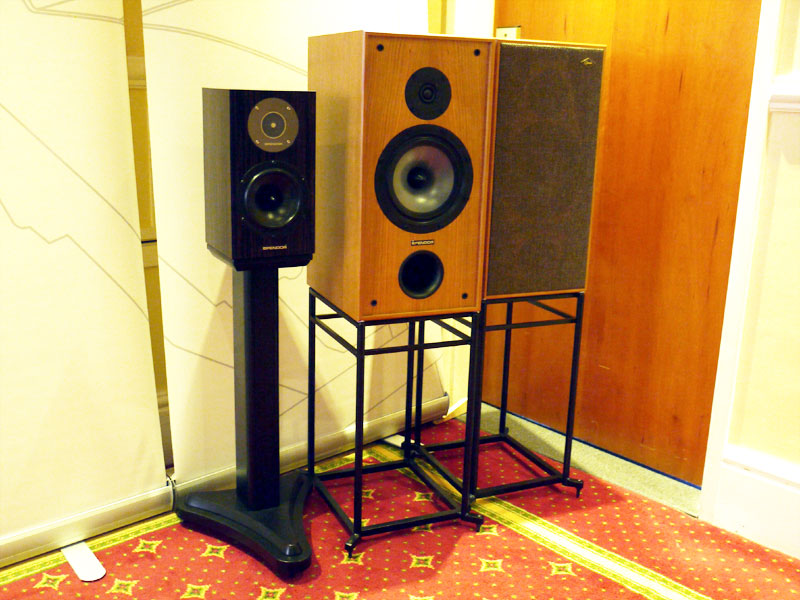
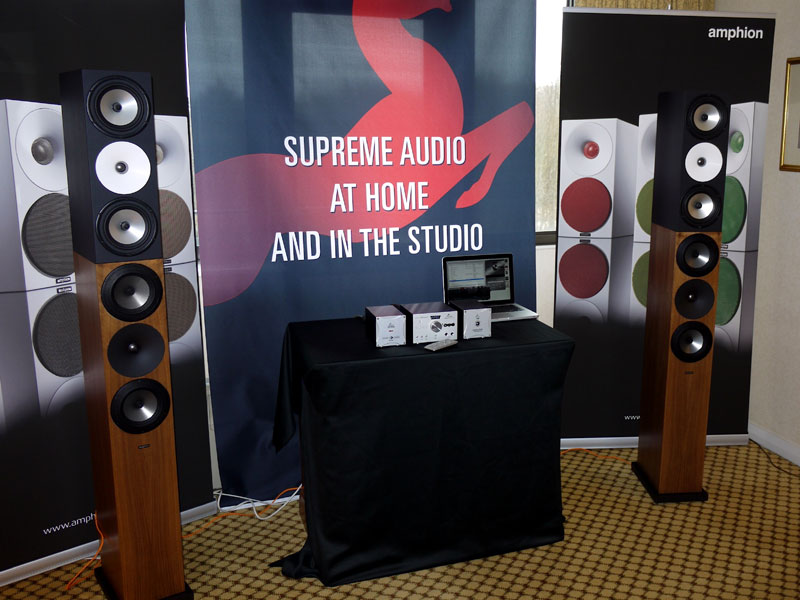
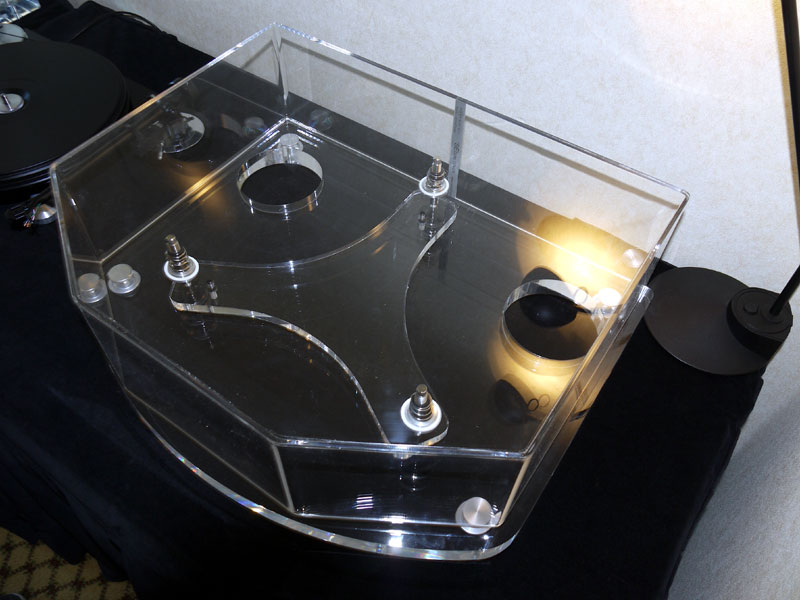
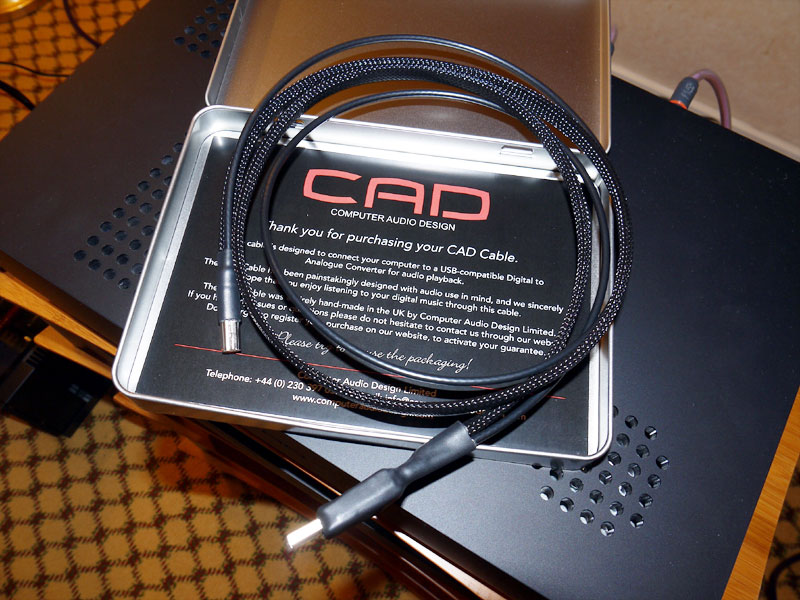
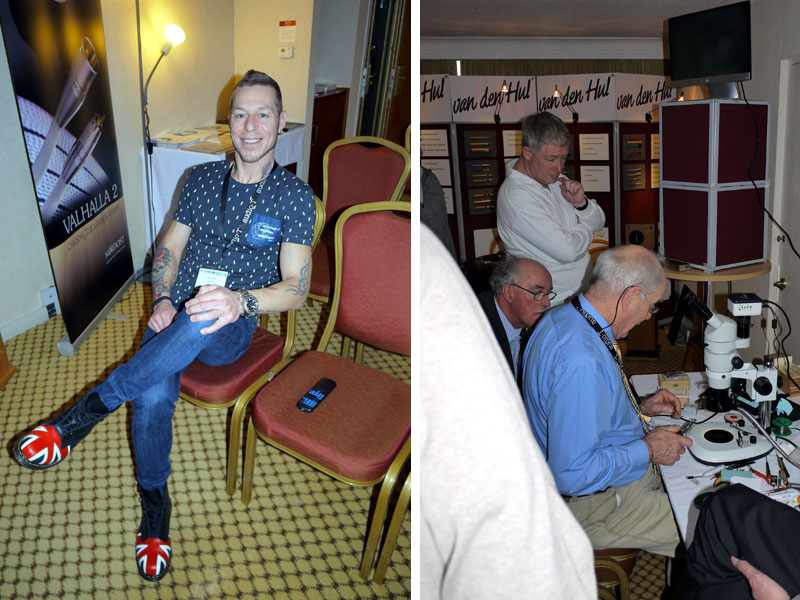

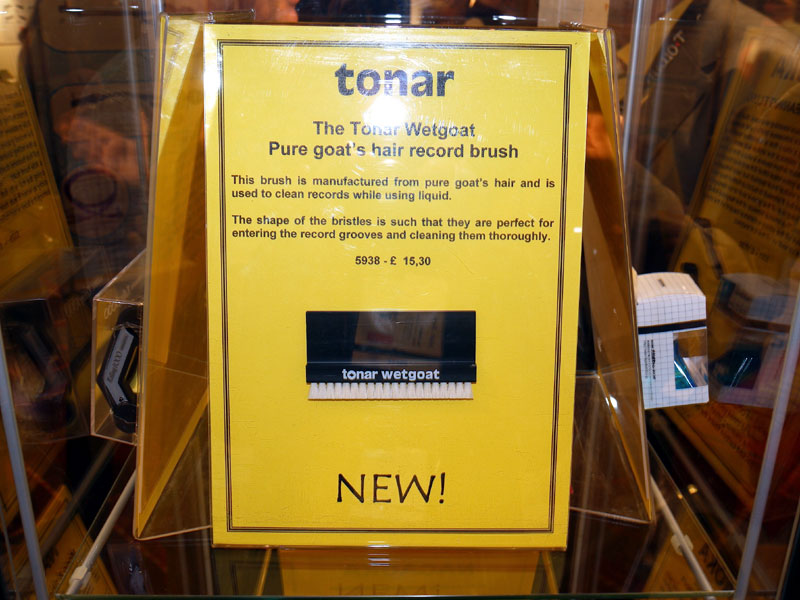
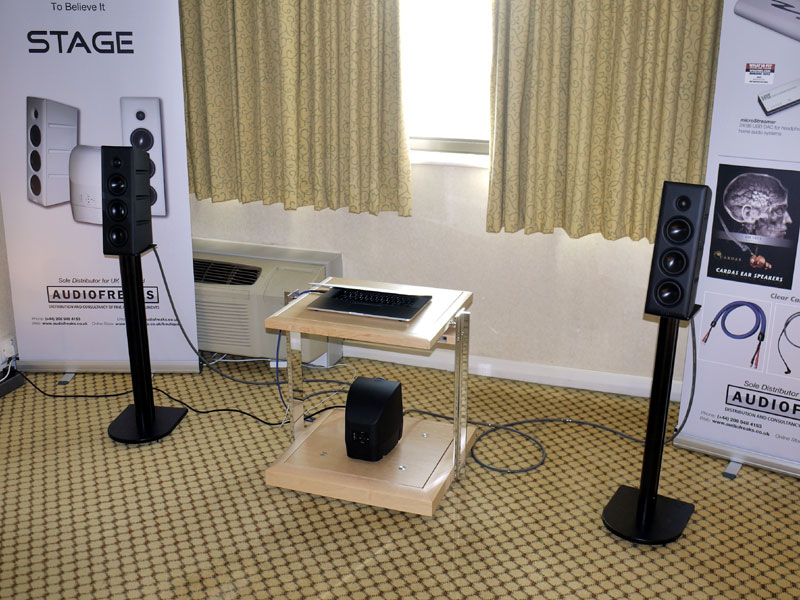
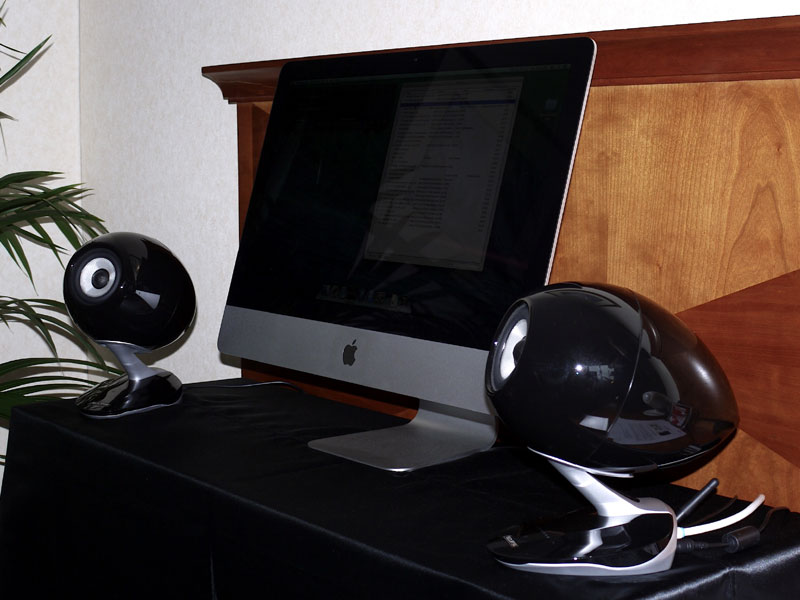
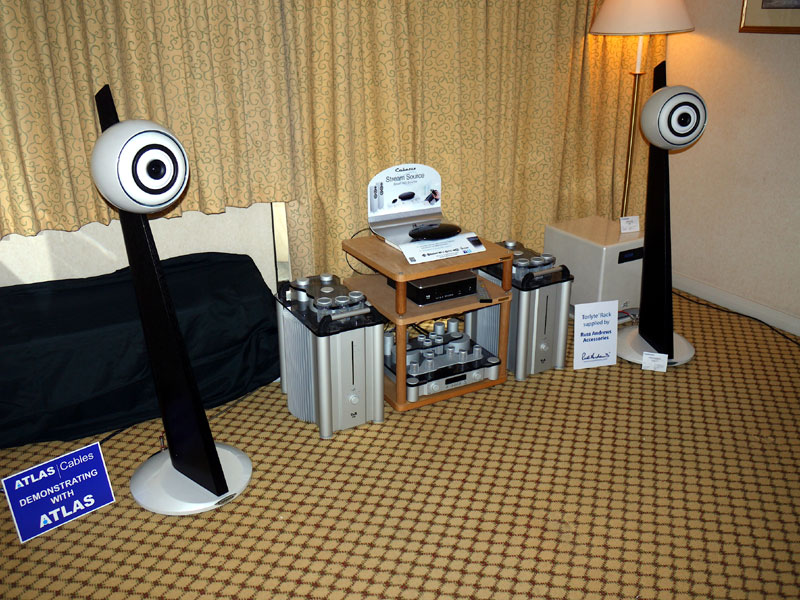
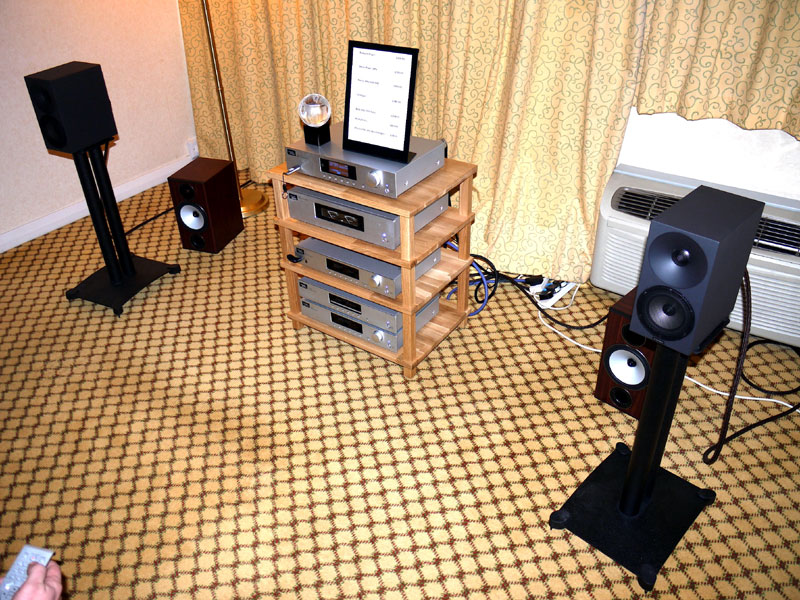
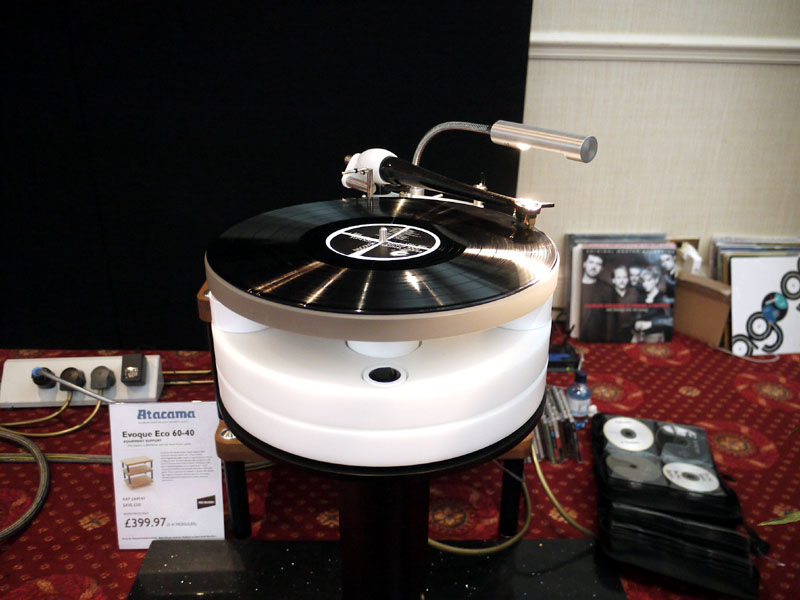

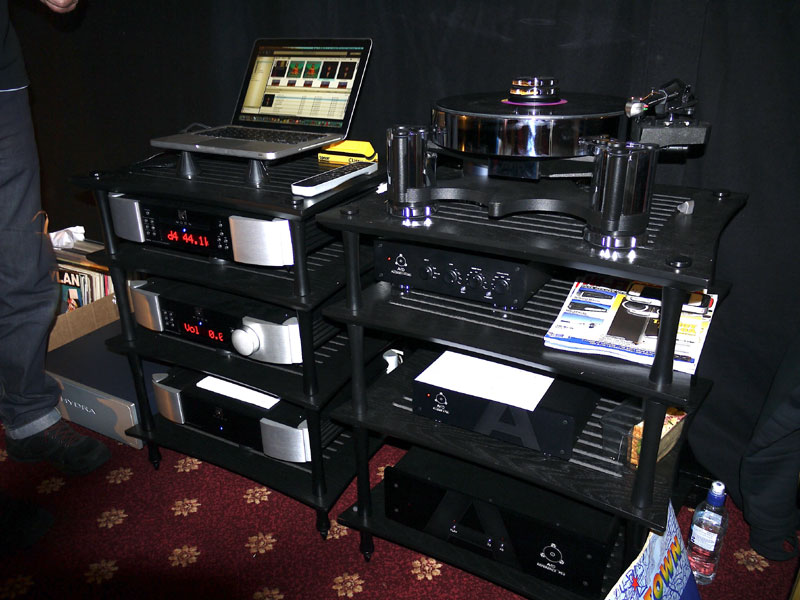
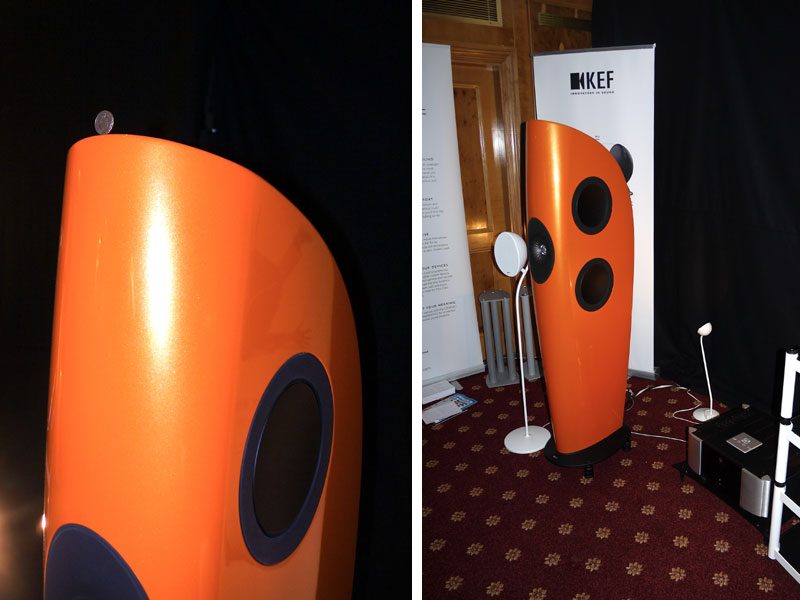
 Which brings us, naturally,
to the annual Bristol Duck For Cover award.
Which brings us, naturally,
to the annual Bristol Duck For Cover award.